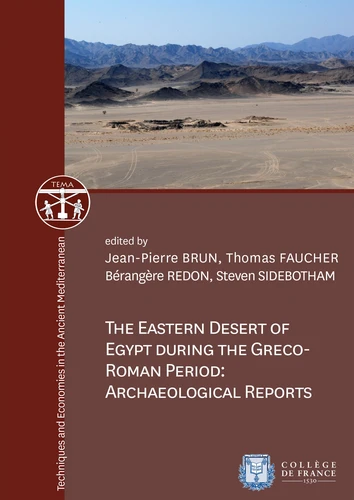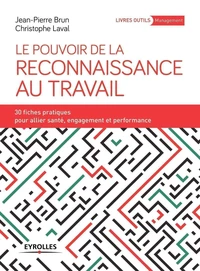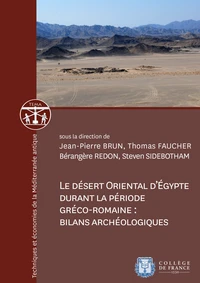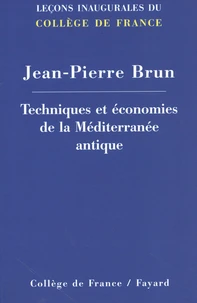The Eastern Desert of Egypt during the Greco-Roman Period: Archaeological Reports
Par : , , ,Formats :
Disponible dans votre compte client Decitre ou Furet du Nord dès validation de votre commande. Le format Multi-format est :
- Pour les liseuses autres que Vivlio, vous devez utiliser le logiciel Adobe Digital Edition. Non compatible avec la lecture sur les liseuses Kindle, Remarkable et Sony
 , qui est-ce ?
, qui est-ce ?Notre partenaire de plateforme de lecture numérique où vous retrouverez l'ensemble de vos ebooks gratuitement
Pour en savoir plus sur nos ebooks, consultez notre aide en ligne ici
- FormatMulti-format
- ISBN978-2-7226-0488-9
- EAN9782722604889
- Date de parution14/09/2018
- Protection num.NC
- Infos supplémentairesMulti-format incluant PDF avec W...
- ÉditeurCollège de France
Résumé
The Eastern Desert of Egypt extends over a vast area of mountains and sandy plains between the Nile and the Red Sea. Its natural riches -gold, gems and high quality stones (such as granite from Mons Claudianus, Tiberianè or Ophiatès, porphyry from Porphyritès, basanites [greywacke] from the Wâdi al-Hammâmât, etc.)- have, despite the difficulties due to harsh climatic conditions, been exploited since the Predynastic period.
The Pharaohs, the Ptolemies and the Roman emperors often sent expeditions to extract these minerals and stones. The desert was also a passageway for all sorts of traffic coming from countries bordering the Red Sea and the Indian Ocean. Expeditions and commercial activities, which started from time of the Old Kingdom, greatly expanded during the Ptolemaic and Roman periods. Trade focused on spices initially, fragrant resins and gems, then in the Roman period, on a wide range of exotic products including pearls, precious stones, fabrics, etc.
The archaeological sites of this region were practically inaccessible for logistical reasons until recently and they were, until now, exceptionally well preserved. Between the late 1970's and 2012, American, English, Italian and French teams were able to explore or search hundreds of sites, significantly improving our understanding of gold mining under the Ptolemies and the Byzantine emperors, granite and porphyry quarries opened by the Roman emperors, and trade with Arabia and India through the ports of Myos Hormos and Berenike...
The Pharaohs, the Ptolemies and the Roman emperors often sent expeditions to extract these minerals and stones. The desert was also a passageway for all sorts of traffic coming from countries bordering the Red Sea and the Indian Ocean. Expeditions and commercial activities, which started from time of the Old Kingdom, greatly expanded during the Ptolemaic and Roman periods. Trade focused on spices initially, fragrant resins and gems, then in the Roman period, on a wide range of exotic products including pearls, precious stones, fabrics, etc.
The archaeological sites of this region were practically inaccessible for logistical reasons until recently and they were, until now, exceptionally well preserved. Between the late 1970's and 2012, American, English, Italian and French teams were able to explore or search hundreds of sites, significantly improving our understanding of gold mining under the Ptolemies and the Byzantine emperors, granite and porphyry quarries opened by the Roman emperors, and trade with Arabia and India through the ports of Myos Hormos and Berenike...
The Eastern Desert of Egypt extends over a vast area of mountains and sandy plains between the Nile and the Red Sea. Its natural riches -gold, gems and high quality stones (such as granite from Mons Claudianus, Tiberianè or Ophiatès, porphyry from Porphyritès, basanites [greywacke] from the Wâdi al-Hammâmât, etc.)- have, despite the difficulties due to harsh climatic conditions, been exploited since the Predynastic period.
The Pharaohs, the Ptolemies and the Roman emperors often sent expeditions to extract these minerals and stones. The desert was also a passageway for all sorts of traffic coming from countries bordering the Red Sea and the Indian Ocean. Expeditions and commercial activities, which started from time of the Old Kingdom, greatly expanded during the Ptolemaic and Roman periods. Trade focused on spices initially, fragrant resins and gems, then in the Roman period, on a wide range of exotic products including pearls, precious stones, fabrics, etc.
The archaeological sites of this region were practically inaccessible for logistical reasons until recently and they were, until now, exceptionally well preserved. Between the late 1970's and 2012, American, English, Italian and French teams were able to explore or search hundreds of sites, significantly improving our understanding of gold mining under the Ptolemies and the Byzantine emperors, granite and porphyry quarries opened by the Roman emperors, and trade with Arabia and India through the ports of Myos Hormos and Berenike...
The Pharaohs, the Ptolemies and the Roman emperors often sent expeditions to extract these minerals and stones. The desert was also a passageway for all sorts of traffic coming from countries bordering the Red Sea and the Indian Ocean. Expeditions and commercial activities, which started from time of the Old Kingdom, greatly expanded during the Ptolemaic and Roman periods. Trade focused on spices initially, fragrant resins and gems, then in the Roman period, on a wide range of exotic products including pearls, precious stones, fabrics, etc.
The archaeological sites of this region were practically inaccessible for logistical reasons until recently and they were, until now, exceptionally well preserved. Between the late 1970's and 2012, American, English, Italian and French teams were able to explore or search hundreds of sites, significantly improving our understanding of gold mining under the Ptolemies and the Byzantine emperors, granite and porphyry quarries opened by the Roman emperors, and trade with Arabia and India through the ports of Myos Hormos and Berenike...

















